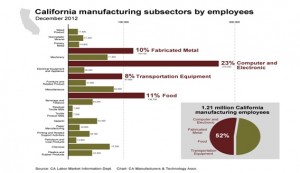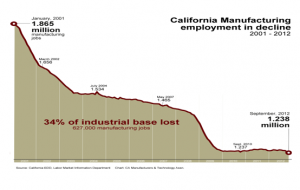On Thursday, December 4th, CONNECT held its 27th Annual Most Innovative New Product (MIP) Award dinner to honor San Diego companies that had launched innovative new products within the last year. There were more than 700 attendees at the event held at the Hyatt Regency La Jolla at Aventine, led by Mistress of Ceremonies Maureen Cavanaugh of the Midday Edition of KPBS. There were 102 nominations that were narrowed down to 24 finalists by 100 judges, culminating in eight new MIP winners. The 2014 MIP Award winners selected were:
Aerospace & Security Technologies
CyberFlow Analytics for FlowScape – The “platform enables Advanced Threat Protection through a sophisticated Anomaly Detection system and has been designed in a modular fashion in alignment with cloud computing principles and runs entirely in the context of virtual machines…the system involves a series of connected multi-model ‘analytics engines’ that contain hundreds of mathematical predictors that can machine learn network communication transmissions and identify odd anomalous behavior across an entire network…[It} is scalable to handle big data network and application flows through cloud-ready virtualized analytics engines.”
The other finalists were: Cubic Defense Applications for Halo Array, 3D Robotics for IRIS, Space Micro, Inc. for IPC7000, Image Processing Computer.
Communications & IT
Cubic Transportation Systems for NextBus Fleet Management Application – The “application is a modular, mobile gateway for connecting passengers and public transport operators to valuable real-time travel and operations information. For passengers, this means knowing exactly where their next bus is so they know how long their wait time is. For operators, it is a cost-effective, high-quality and reliable application to keep buses on schedule and drive efficiencies in their services.”
This award shows that long-established company can still develop an innovative new product. Cubic Transportation System is “the leading provider of revenue collection management systems and services worldwide” and is one of three business segments of parent company, Cubic Corporation. Walter J. Zable founded Cubic Corporation as a small electronics company in San Diego in 1951, and he remained involved in the management of the company as CEO until his death in 2012 at the age of 97.
The other two segments are:
Mission Support Services is “an industry leader in providing comprehensive support services for all echelons of national militaries and security forces in the U.S. and allied nations.”
Cubic Defense Applications is “the leading provider of live air and ground combat training systems worldwide, a key supplier of virtual and immersive training systems, communications and electronics products, and an emerging provider of cyber technologies and global tracking solutions for commercial and national military customers.”
I started working at Cubic Defense when I was 19 years old for the Chief Scientist, Chief Physicist, and a Staff Engineer in the Marketing Department. The latter had previously developed the geodetic SECOR satellite surveying system, the first of its kind to produce a direct coast-to-coast measurement of the United States long before the Global Positioning System was developed. He was on the fast track for advancement and was promoted to Marketing Manager three years later, and I moved up with him as his assistant at age 22. When I started my own manufacturers’ sales rep agency in 1985, both Cubic Transportation and Cubic Defense became customers for companies that I have represented over the years.
The other finalists were: DVEO division of Computer Modules, Inc. for Ad+EAS Serter™ and Tricopian, LLC for FuelRod.
Diagnostics & Research Tools
Organovo, Inc. for 3D Human Liver Model – “Organovo’s Bioprinted Human Tissue Models are multi-cellular, dynamic, and functional 3D human tissue models for preclinical testing and drug discovery research. Created using proprietary 3D bioprinting process, the tissues remain viable and dynamic for extended time in vitro and exhibit key architectural and functional features that mimic key aspects of the natural 3D tissue environment. Biochemical, genomic, proteomic and unique histologic endpoints can be assessed over time.”
In addition to the MIP award, the life science magazine The Scientist’s selected Organovo’s ex Vive 3D human liver tissue for the seventh place spot of the top 10 innovations for 2014.
The other finalists were: bioTheranostics, Inc for Breast Cancer Index (BCI) and Edico Genome for DRAGEN Bio-IT Processor.
Mobile Apps
Rock My World, Inc. for RockMyRun – this is a mobile app that takes biometric data from smart phones and fitness wearable devices “to adjust the tempo of the music you’re listening to in order to match your pace or motivate you to push just a little harder.”
The other finalists were: GreatCall for Urgent Care and Visual Mobility Inc. for SEENiX.
Pharmaceutical Drugs and Medical Devices
Topera, Inc. for Topera’s 3D Mapping System – the system “consists of the FDA cleared and CE marked RhythmView™ Workstation and FIRMap™ Catheter, which are used in combination for the identification and localization of the sustaining mechanisms of cardiac arrhythmias such as atrial fibrillation, atrial flutter, atrial tachycardia, and ventricular tachycardia.”
On October 30, 2014, the Chicago-based healthcare company, Abbott announced it would acquire Topera “with all outstanding equity for $250 million upfront with potential future payments tied to performance milestones.”
The other finalists were: Bioness for Vector Gait and Safety System and Diazyme for 25-OH Vitamin D Assay for Clinical Chemistry Analyzers.
Software
CloudBeds for CloudBeds – It is an operating system for hotels to “provide the hotel with an automated website, booking engine, Facebook presence, revenue management platform, distribution channels, rate and package manager, and light-weight property management system. The system “automates many of these functions so that an hotelier can focus on its guests instead of managing its property and selling its rooms.” Their “goal is to continue to help streamline connectivity between small hotels and their customers using the latest innovations in software — improving their operational and communication efficiencies.” Their focus is on “the large developing world marketplace.”
The other finalists were: Intific for NeuroBridge 2.0 and Raken, Inc. for Raken.
Sport & Active Lifestyle Technologies
Electrozyme LLC for ProFit SE Real-Time Sweat Electrolyte Sensor – this is world’s first wearable personal hydration monitor that can asses assess fluid and electrolyte loss in a real-time non-invasive way to determine if it’s time to rehydrate, what to rehydrate with, and how much to rehydrate.
The other finalists were: Bast Surf for Bast and Cardiff Skate Co. for Cardiff Skates.
Sustainability
Solatube International for Solatube SkyVault Series – the patented technologies of the Sky Vault series combines breakthrough optics with progressive engineering to enhance light capture, focus light over greater distances, or spread light evenly throughout a space.
I wrote about Solatube in the second edition of my book because they “reshored” by returning manufacturing from China to their plant in Vista at the end of 2011, partially because of the risk of intellectual property theft of their proprietary technologies, in addition to increasing costs and difficulty in managing their offshore manufacturing.
The other finalists were: Blue Wave International, Inc. for ClearWaveAir and Measurabl for Measurabl.
Two other awards were given at the event: CONNECT’s Distinguished Contribution Award for Life Sciences Innovation was awarded to philanthropist T. Denny Sanford received, and the Distinguished Contribution Award for Technology Innovation was awarded to Dr. Robert S. Sullivan, Dean of the Rady School of Management, University of California, San Diego.
From inventors being educated and mentored through the San Diego Inventors Forum to entrepreneurial teams developing technology based products being assisted and mentored through CONNECT’s Springboard program, San Diego is a hotbed of innovation. “Since the inception of the program in 1993, more than 3000 scientific and technological breakthroughs have been guided through the process of innovation to commercialization. Together, these companies have raised over $ 1.4 Billion in capital.” To me, this makes San Diego the “Silicon Beach” of California.

